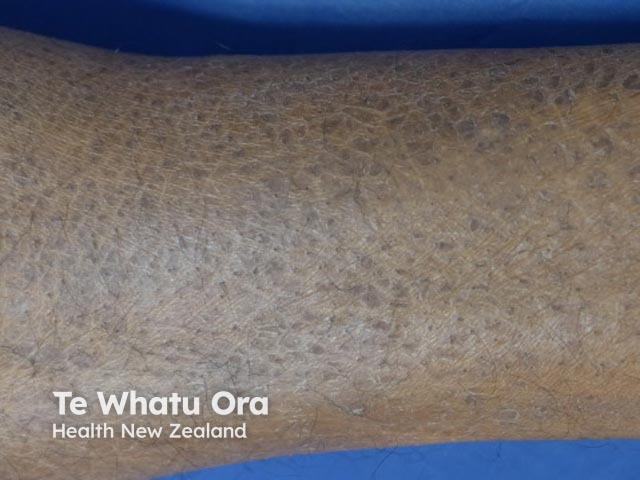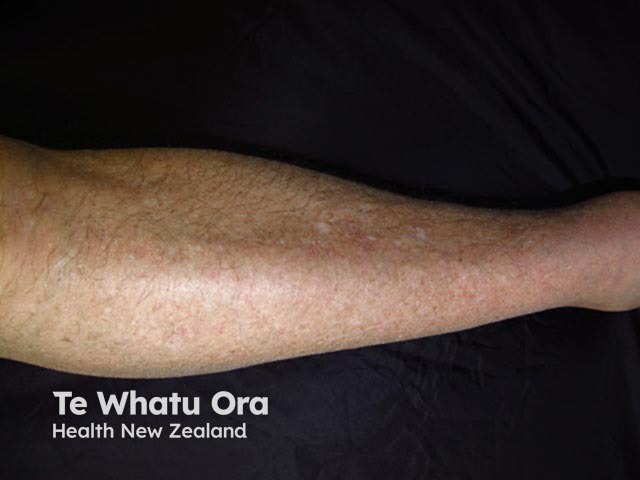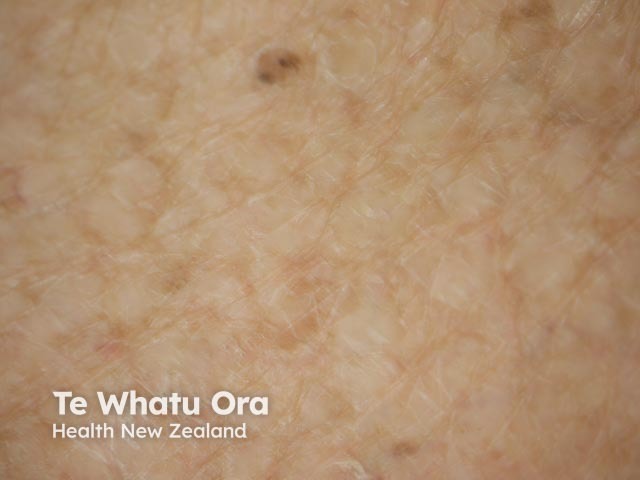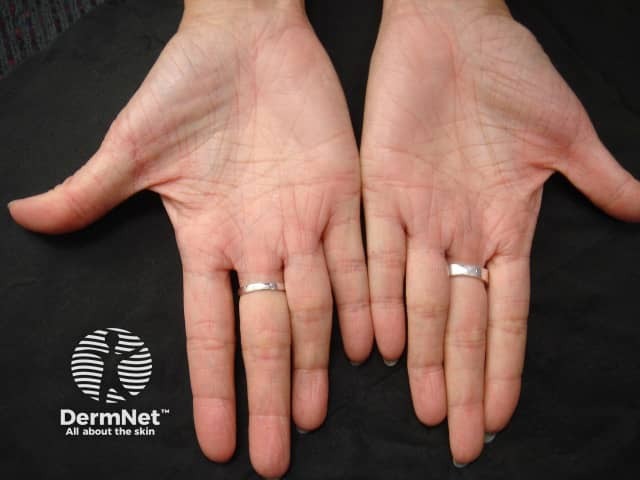Main menu
Common skin conditions

NEWS
Join DermNet PRO
Read more
Quick links
Ichthyosis vulgaris — extra information
Ichthyosis vulgaris
Author: Natasha Lee BSc (Hons), Medical Student, University of Leeds, United Kingdom, 2014.
Introduction Causes Demographics Clinical features Diagnosis Treatment
What is ichthyosis vulgaris?
Ichthyosis vulgaris is characterised by excessive dry, scaly skin. It is the most common form of the inherited ichthyoses. The name “ichthyosis“ is derived from the Greek root “ichythys” meaning fish, to which ichthyosis vulgaris owes its other names, “fish scale disease,” or “fish skin disease”; “vulgaris” means common.
Ichthyosis vulgaris may be inherited or acquired. This page focuses on the more common inherited form.
What causes ichthyosis vulgaris?
Ichthyosis vulgaris results from loss-of-function mutations in the gene encoding the protein filaggrin (FLG), which is mapped on the epidermal differentiation complex on chromosome 1q21. The mutations lead to defective production of filaggrin.
Filaggrin is a filament-associated epidermal protein required for the binding of keratin fibres in epidermal cells, to form an effective skin barrier. It helps maintain the skin pH, retain moisture in the stratum corneum, and reduce trans-epidermal water loss (TEWL).
Xerosis or dryness results from the reduced skin hydration associated with defective filaggrin. Excessive scale results from the inability of the squames (skin cells) to remain hydrated as they move upward through the stratum corneum. Hyperkeratosis results from compensatory repair mechanisms increasing cell proliferation.
Who gets ichthyosis vulgaris?
Ichthyosis vulgaris affects 1 in every 250 people. Filaggrin mutations have been reported most commonly in Europeans; prevalence in other races is under investigation.
Ichthyosis vulgaris is an autosomal semidominant condition. Semidominant means that a mutation in one gene of the chromosome pair results in a mild version of the disease, whereas a mutation in both genes on the chromosome pair results in a moderate to severe form.
What are the clinical features of ichthyosis vulgaris?
Symptoms vary in severity and tend to be less severe in a warm, humid climate.
- Ichthyosis vulgaris is usually not present at birth. Most often it appears after about 2 months and in most cases before the age of 5. Symptoms may worsen up to puberty, and sometimes improve with age.
- Dry scaly skin (xerosis) affects the extensor aspect of the limbs, scalp, central face and trunk. Skin folds are usually spared (neck, armpits, elbow and knee creases). There may be chapping (painful fissuring ) of palms and soles.
- Ichthyosis vulgaris is associated with keratosis pilaris (follicular hyperkeratosis) and hyperlinearity (pronounced skin lines) of palms and soles.
Atopic dermatitis (eczema) is present in 50% of people with ichthyosis vulgaris (and 8% of those with atopic eczema have the features of ichthyosis vulgaris). When atopic dermatitis is associated with severe ichthyosis vulgaris, the dermatitis tends to be early in onset, severe, and more likely to persist into adult life. There is also an increased risk of asthma, rhinitis and food allergy.

Ichthyosis vulgaris

Ichthyosis vulgaris

Ichthyosis vulgaris

Ichthyosis vulgaris
How is ichthyosis vulgaris diagnosed?
Ichthyosis vulgaris is usually a clinical diagnosis. Mild ichthyosis is often just called 'dry skin'.
Filaggrin mutations can be detected by research laboratories from a buccal smear or saliva sample.
On skin biopsy, histology shows hyperkeratosis in the stratum corneum and reduced or absent granular layer. Electron microscopy also shows reduced or absent keratohyaline granules, of which the main component is the protein pro-filaggrin, the precursor to the filaggrin.
What is the treatment of ichthyosis vulgaris?
Treatment aims to reduce dryness, scaling, splitting and thickening of the skin. This is achieved with exfoliation and moisturising on a regular, daily basis.
Treatments to keep the skin hydrated
Apply emollients with high lipid content, such as lanolin cream (a sebum-like substance derived from wool-bearing animals).
Treatments to reduce scale
- Bathe in salt water.
- Apply creams or lotions containing salicylic acid, glycolic acid, lactic acid or urea to exfoliate and moisturise skin. These may irritate active eczema.
- Oral retinoids such as acitretin or isotretinoin can be prescribed in severe cases.
General tips
- Apply lotions and creams to damp skin to trap in the moisture (within 3 minutes of showering/bathing).
- Lotion and creams can be kept under occlusion for 1 or 2 hours with a cling-film wrap to enhance skin hydration.
- Gently rub a pumice stone on wet skin to help remove thickened crusty skin.
- Brush washed hair to remove scales from scalp.
References
- Thyssen JP, Godoy-Gijon E, Elias PM, et al. Ichthyosis vulgaris: the filaggrin mutation disease. Br J Dermatol 2013; 168: 1155–66. DOI: 10.1111/bjd.12219. PubMed
- Brown S, McLean WH. One remarkable molecule: Filaggrin. J Invest Dermatol 2012; 132: 751–62. DOI: 10.1038/jid.2011.393. PubMed Central
On DermNet
- Ichthyosis
- Epidermolytic ichthyosis
- Keratosis pilaris
- Atopic dermatitis
- Ichthyosis vulgaris
- Recessive X-linked ichthyosis
- Netherton syndrome
- Harlequin ichthyosis
- Dry skin
- Dermatitis neglecta
- Emollients and moisturisers
- Epidermolytic hyperkeratosis
- Scaly skin conditions
Other websites
- Ichthyosis vulgaris — OMIM entry #146700
- Hereditary and Acquired Ichthyosis Vulgaris — Medscape Reference
- Ichthyosis vulgaris — Medline Plus
- Ichthyosis vulgaris — American Academy of Dermatology
